2020年人教新目标英语英语九年级unit3 单元知识点总结归纳
2020年春人教新目标英语九年级英语unit3知识点分析与练习(无答案)
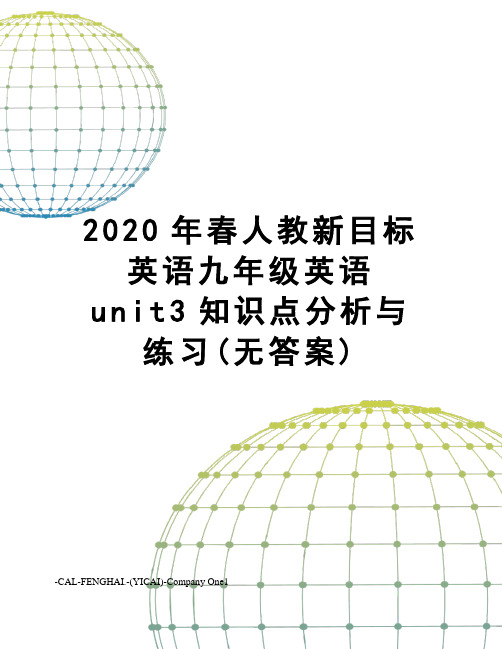
2020年春人教新目标英语九年级英语u n i t3知识点分析与练习(无答案)-CAL-FENGHAI.-(YICAI)-Company One12020年春人教新目标英语九年级英语Unit3 Could you please tell me where the restrooms are知识点一、重点短语:1. 买一些杂志 get some magazines2. 路过书店 go past the bookstore3. 路过,经过 pass by4. 走上前,朝….走去 walk up to5. 对不起请再说一次 pardon me6. 地下停车场 underground parking lot7. 盼望,期待 look forward to 8. 在某人去…的路上 on one’s way to …9. 在…..拐角处/角落里 on(in/at) the corner of…. 10. 向左/右转 turn left/right11. 去三楼 go to the third floor 12. 抓住我的手 hold my hand13. 在银行与超市之间 between the bank and the supermarket 14. 听起来完美 sound perfect15. 沿着这条街向东走 go east along this street 16. 一个吃饭的好地方a good place to eat17. 礼貌地请求帮助ask for help politely 18. 在不同的情景 in different situations19. 电子邮件地址 e-mail address 20. 导入一个问题 lead in to a request21. 匆忙地 be in a rush 22. 更好地规划我的时间plan my time better二、重点句子:讲一讲1(section A)1.特殊疑问词引导的宾语从句:(1)宾语从句的连接词:特殊疑问句的疑问词通常有疑问代词what, which , who , whose和疑问副词Where , when , why , how等。
人教版新目标九年级英语新版本unit 3知识点
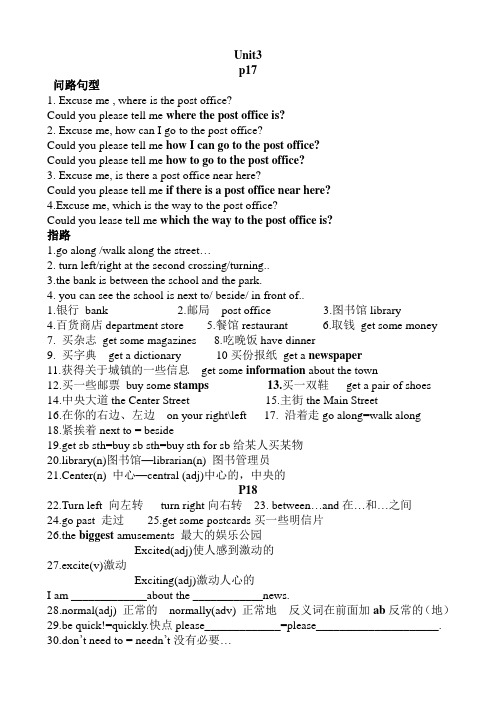
Unit3p17问路句型1. Excuse me , where is the post office?Could you please tell me where the post office is?2. Excuse me, how can I go to the post office?Could you please tell me how I can go to the post office?Could you please tell me how to go to the post office?3. Excuse me, is there a post office near here?Could you please tell me if there is a post office near here?4.Excuse me, which is the way to the post office?Could you lease tell me which the way to the post office is?指路1.go along /walk along the street…2. turn left/right at the second crossing/turning..3.the bank is between the school and the park.4. you can see the school is next to/ beside/ in front of..1.银行bank2.邮局post office3.图书馆library4.百货商店department store5.餐馆restaurant6.取钱get some money7. 买杂志get some magazines8.吃晚饭have dinner9. 买字典get a dictionary 10买份报纸get a newspaper11.获得关于城镇的一些信息get some information about the town12.买一些邮票buy some stamps 13.买一双鞋get a pair of shoes 14.中央大道the Center Street 15.主街the Main Street16.在你的右边、左边on your right\left 17. 沿着走go along=walk along18.紧挨着next to = beside19.get sb sth=buy sb sth=buy sth for sb给某人买某物20.library(n)图书馆—librarian(n) 图书管理员21.Center(n) 中心—central (adj)中心的,中央的P1822.Turn left 向左转turn right向右转23. between…and在…和…之间24.go past 走过25.get some postcards买一些明信片26.the biggest amusements 最大的娱乐公园Excited(adj)使人感到激动的27.excite(v)激动Exciting(adj)激动人心的I am _____________about the ____________news.28.normal(adj) 正常的normally(adv) 正常地反义词在前面加ab反常的(地)29.be quick!=quickly.快点please_____________=please_____________________.30.don’t need to = needn’t没有必要…31.rush to do sth 匆匆去做某事P1931.I wonder where we should go next.= I wonder where to go next.Wonder= want to know 想知道32. hold one’s hand 抓住某人的手scared(adj)让人感到害怕的33.scare (v)使害怕scaring (adj)吓人的34.suggest (v)建议suggestion (n) 建议。
人教版新目标九年级全一册英语 Unit 3 知识点考点复习提纲

人教版新目标九年级全一册英语Unit 3 知识点考点复习提纲Unit 3 Could you please tell me where the restrooms are?【重点短语】Section Abuy some stamps 买一些邮票get to the bookstore 到书店on one’s right / left 在某人的右边 / 左边beside the bank 在银行旁边turn right / left 右拐 / 左拐between the flower store and the bookstore 在花店和书店之间go past the bookstore 经过书店be excited to do sth. 对做某事感到兴奋try the rides 尝试乘骑项目start with ... 以……开始need to do sth. 需要做某事come on 快点儿hold one’s hand 抓住某人的手at first 首先;最初get hungry 饿了serve delicious food 提供美味的食物on one’s way to ... 在某人去……的路上pass by 路过;经过a rock band 一个摇滚乐队walk up to sb. 向某人走去come a little earlier 早点儿来pardon me 抱歉,对不起;什么,请再说一遍mail a letter 寄信go east 朝东走Section Bvisit a foreign country 去国外游览ask for help politely 礼貌地请求帮助sound less polite / impolite 听起来不怎么礼貌 / 不礼貌a direct question 一个直接的问题in different situations 在不同的情况下depend on 取决于speak to sb. 和某人说话school trip 学校旅行such as 诸如e-mail address 电子邮箱地址lead in to a request 导入请求spend time (in) doing sth. 花费时间做某事trouble sb. 麻烦某人communicate better with other people 更好地与他人交流an underground parking lot 一个地下停车场pass the salt 递一下盐change some money 兑换一些钱go on a short study vacation 去游学an English-speaking country 一个讲英语的国家in a rush 急忙地on time 按时【考点详解】1. ①问路常用的句子:Do you know where is …?Can you tell me how can I get to …?Could you tell me how to get to …?②Can/Could/Will/Would you please tell me sth. 表示十分客气地询问事情③Could you tell me how to get to the park? 请你告诉我怎么才能去邮局好吗?上面句子中的how to get to the park是疑问词与动词不定式连用,用作宾语,但不是宾语从句(这一点要搞清楚,它不是宾语从句),相当于how I can get to the park(宾语从句)I don't know how to solve the problem=I don't know how I can solve the problem. 我不知道如何解决这个问题Can you tell me when to leave? =Can you tell me when I will leave? 你能告诉我什么时候离开?。
人教版(新目标)初中英语九年级上册Unit3知识点总结汇总

Unit3 单词请点击绿标播放restroom [ˈrestru:m] n.(美)洗手间;公共厕所stamp [stæmp] n. 邮票;印章bookstore [ˈbukstɔ:(r)] n. 书店beside[bɪˈsaɪd] prep. 在……旁边;在……附近postcard [ˈpəustka:(r)d] n. 明信片pardon [ˈpa:(r)dn] v. 原谅 interj.请再说一遍washroom [ˈwɔʃru:m] n. 洗手间;厕所bathroom [ˈbɑ:θru:m]n. 浴室;洗手间normally ['nɔ:rməli] adv.通常;正常情况下rush [rʌʃ] v. & n. 仓促;急促suggest [səˈdʒest] v. 建议;提议pass by 路过;经过staff [sta:f] n. 管理人员;职工grape [greip] n. 葡萄central [ˈsentrəl] adj. 中心的;中央的Nearby [ˌnɪrˈbaɪ] adj.附近的;邻近的adv.在附近;附近Pardon me 抱歉, 对不起;什么,请再说一遍mail [meil] v. 邮寄;发电子邮件n. 邮件east [i:st] adj. 东方的;东部的adv.向东;n.东方fascinating [ˈfæsineitiŋ] adj.迷人的;有吸引力的. Inexpensive[ˌɪnɪkˈspensɪv] adj.不昂贵的Uncrowded [ʌnˈkraʊdɪd] adj.不拥挤的;人少的convenient [kənˈvi:niənt] adj. 便利的;方便的mall [mɔ:l] n. 商场;购物中心clerk [kla:k][kl:rk] n. 职员corner [ˈkɔ:(r)nə(r)] n. 拐角;角落politely [pəˈlaitli] adv. 礼貌地;客气地request [riˈkwest]n. 要求;请求direction [diˈrekʃn] [daiˈrekʃn] n. 方向;方位correct [kəˈrekt] adj. 正确的;恰当的polite [pəˈlait] adj. 有礼貌的;客气的. direct [diˈrekt, daiˈrekt]adj. 直接的;直率的. speaker [ˈspi:kə] n.讲(某种语言)的人;发言者whom [hu:m] pron. 谁;什么人impolite [ˌɪmpəˈlaɪt] adj. 不礼貌的;粗鲁的address [əˈdres], [ˈædres] n.住址;地址;通讯处. Underground [ˈʌndəɡraʊnd] adj.地下的;n.地铁Parking lot n.停车场course [kɔ:(r)s] n. 课程;学科Italian [Iˈtæli ən] adj.意大利人的;n.意大利人语Tim [tim] 蒂姆(男名)02Unit3 知识梳理Unit3 Could you please tell me where ....【重点短语】1.a pair of 一对,一双,一副2.between A and B 在a和b之间3.on one’s / the way to 在去……的路上4.pardon me 什么,请再说一遍5.pass by 路过经过6.look forward to 盼望期待7.excuse me 打扰了请原谅8.get some information about 获取有关……的一些信息9.turn leftight 向左向右转10.go past 经过路过11.a little earlier 早一点儿12.a good place to eat 一个吃饭的好地方13.in different situation 在不同的情况下14.on time 准时按时15.get to 到达16.have dinner 吃晚餐17.on one’s / he right在右边e on 快点请过来19.the shopping center 购物中心20.the corner of....... 的角落/拐角处21.lead into 导入,引入【重点句型】1.问路常用的句子:①Do you know where is … ?②Can you tell me how can I get to …?③Could you tell me how to get to …?④Could/Will/Would you please tell me sth.表示十分客气地询问事情Could you tell me how to get to the park?请你告诉我怎么才能去邮局好吗?2. decide to do 决定做…...She decided to go to have lunch. 她决定去吃午餐。
人教新目标九年级Unit 3 知识点总结归纳
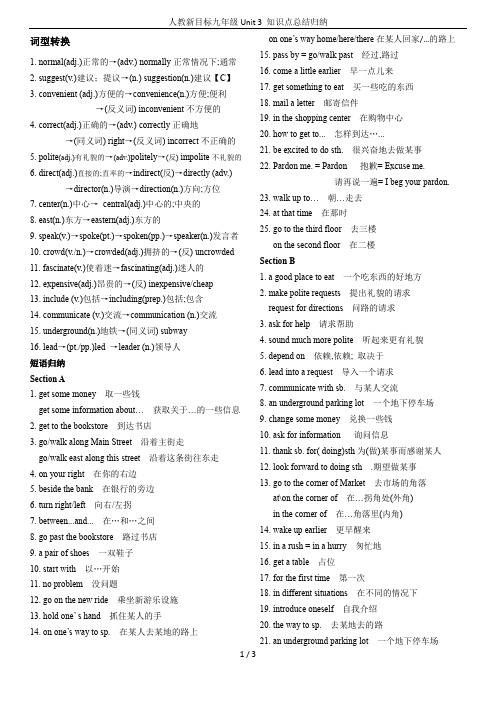
词型转换1. normal(adj.)正常的→(adv.) normally正常情况下;通常2. suggest(v.)建议;提议→(n.) suggestion(n.)建议【C】3. convenient (adj.)方便的→convenience(n.)方便;便利→(反义词) inconvenient不方便的4. correct(adj.)正确的→(adv.) correctly正确地→(同义词) right→(反义词) incorrect不正确的5. polite(adj.)有礼貌的→(adv.)politely→(反) impolite不礼貌的6. direct(adj.)直接的;直率的→indirect(反)→directly (adv.)→director(n.)导演→direction(n.)方向;方位7. center(n.)中心→central(adj.)中心的;中央的8. east(n.)东方→eastern(adj.)东方的9. speak(v.)→spoke(pt.)→spoken(pp.)→speaker(n.)发言者10. crowd(v./n.)→crowded(adj.)拥挤的→(反) uncrowded11. fascinate(v.)使着迷→fascinating(adj.)迷人的12. expensive(adj.)昂贵的→(反) inexpensive/cheap13. include (v.)包括→including(prep.)包括;包含14. communicate (v.)交流→communication (n.)交流15. underground(n.)地铁→(同义词) subway16. lead→(pt./pp.)led →leader (n.)领导人短语归纳Section A1. get some money 取一些钱get some information about…获取关于…的一些信息2. get to the bookstore 到达书店3. go/walk along Main Street 沿着主街走go/walk east along this street 沿着这条街往东走4. on your right 在你的右边5. beside the bank 在银行的旁边6. turn right/left 向右/左拐7. between...and... 在…和…之间8. go past the bookstore 路过书店9. a pair of shoes 一双鞋子10. start with 以…开始11. no problem 没问题12. go on the new ride 乘坐新游乐设施13. hold one’ s hand 抓住某人的手14. on one’s way to sp. 在某人去某地的路上on one’s way home/here/there在某人回家/…的路上15. pass by = go/walk past 经过,路过16. come a little earlier 早一点儿来17. get something to eat 买一些吃的东西18. mail a letter 邮寄信件19. in the shopping center 在购物中心20. how to get to... 怎样到达…...21. be excited to do sth. 很兴奋地去做某事22. Pardon me. = Pardon 抱歉= Excuse me.请再说一遍= I beg your pardon.23. walk up to…朝…走去24. at that time 在那时25. go to the third floor 去三楼on the second floor 在二楼Section B1. a good place to eat 一个吃东西的好地方2. make polite requests 提出礼貌的请求request for directions 问路的请求3. ask for help 请求帮助4. sound much more polite 听起来更有礼貌5. depend on 依赖,依赖; 取决于6. lead into a request 导入一个请求7. communicate with sb. 与某人交流8. an underground parking lot 一个地下停车场9. change some money 兑换一些钱10. ask for information 询问信息11. thank sb. for( doing)sth为(做)某事而感谢某人12. look forward to doing sth .期望做某事13. go to the corner of Market 去市场的角落at\on the corner of 在…拐角处(外角)in the corner of 在…角落里(内角)14. wake up earlier 更早醒来15. in a rush = in a hurry 匆忙地16. get a table 占位17. for the first time 第一次18. in different situations 在不同的情况下19. introduce oneself 自我介绍20. the way to sp. 去某地去的路21. an underground parking lot 一个地下停车场1 / 322. ask (sb.) about…(向某人)询问关于…的情况知识点总结1.常见的问路句型:(1) Could you please tell me where…is?(2) Could you please tell me how to get to…?(3) Could you please tell me how I can get to…?(4) Could you please tell me the way to…?(5) Excuse me,which is the way to…?(6) Pardon me ,do you know if there is a/an … near here ?(7) Excuse me,would you please show me the way to…? 指路的常用表达方式:直走:Go straight./Go straight head./Go down this road.拐弯:Turn left/ right at the first crossing.Take the first turning on the left/right.指出具体位置:It’s next to the bank/ between the park andthe post office/across from the school.You won’t miss it; It’s on your left/ right.综合指路:(1)Walk along this street, and …is on your left.(2) Go down this way, and turn left at the first crossing ,and you’ll find …is right there , on your left.(3) You can just take No.1 bus, and get off the secondstation. Then you’ll see it2. Could you please (not) do … ? 请你(不要)…好吗?肯定回答:Sure./ Certainly./Of course./No problem./Yes, please.等。
人教版新目标九年级英语Unit3知识点总结
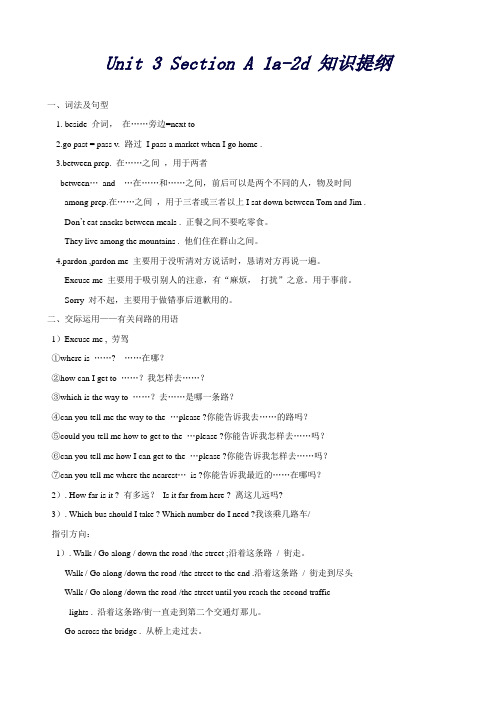
Unit 3 Section A 1a-2d 知识提纲一、词法及句型1. beside 介词,在……旁边=next to2.go past = pass v. 路过I pass a market when I go home .3.between prep. 在……之间,用于两者between…and …在……和……之间,前后可以是两个不同的人,物及时间among prep.在……之间,用于三者或三者以上I sat down between Tom and Jim .Don’t eat snacks between meals . 正餐之间不要吃零食。
They live among the mountains . 他们住在群山之间。
4.pardon ,pardon me 主要用于没听清对方说话时,恳请对方再说一遍。
Excuse me 主要用于吸引别人的注意,有“麻烦,打扰”之意。
用于事前。
Sorry 对不起,主要用于做错事后道歉用的。
二、交际运用——有关问路的用语1)Excuse me , 劳驾①where is ……? ……在哪?②how can I get to ……?我怎样去……?③which is the way to ……?去……是哪一条路?④can you tell me the way to the …please ?你能告诉我去……的路吗?⑤could you tell me how to get to the …please ?你能告诉我怎样去……吗?⑥can you tell me how I can get to the …please ?你能告诉我怎样去……吗?⑦can you tell me where the nearest…is ?你能告诉我最近的……在哪吗?2). How far is it ? 有多远?Is it far from here ? 离这儿远吗?3). Which bus should I take ? Which number do I need ?我该乘几路车/指引方向:1). Walk / Go along / down the road /the street ;沿着这条路/ 街走。
Unit3重点知识人教版九年级英语全册

九年级Unit3重点知识一词形词块拓展① normal adj. 正常的→ normally 正常地② suggest v. 建议→ suggestion n. 建议,提议suggest doing sth. 建议做某事give sb. suggestions 给予某人建议③ center n.中心,中央→ central adj. 中心的;中央的④fascinate v. 使....入迷→ fascinating adj.迷人的,极有吸引力的⑤expensive adj. 昂贵的→ inexpensive adj. 不昂贵的⑥crowd v.挤满n. 人群,观众→ crowded adj.拥挤的→ uncrowded adj.不拥挤的,人少的⑦convenient adj. 便利的,方便的→ convenience n. 方便,便利,适宜,省事It's convenient for sb. to do sth. 对某人来说做某事是便利的sth. is convenient to/for sb. 对某人来说做某事是便利的⑧polite adj. →impolite adj.不礼貌的,粗鲁的→ politely adv. 礼貌地,客气地sound impolite 听起来不礼貌⑨direct adj. 直接的,直率的→directly adv. 径直地;直接地→direction n. 方向,方位→director n.导演,部门负责人sense of direction 方向感⑩speak v. →spoke (过去式)→spoken (过去分词)→speaker 发言者→n.讲话,发言speech⑪who pron. 谁→ whom pron. 谁,什么人→ whose pron. 谁的二、重点短语Section A怎样到达书店how to get to the bookstore 在银行旁边beside the bank在某人的左边/右边on one’s left/ right 左拐/右拐turn left/ turn right 在.....和.....之间between.....and..... 对做某事感到兴奋be excited to do sth. 尝试乘骑项目try the rides 路过,经过pass by = go past买到一些明信片get some postcards 去二楼go to the second floor不必着急don’t need to rush 抓住某人的手hold one’s hand 以.....开始start with 饿了get hungry一个乐队 a rock band 向某人走去walk up to sb.在某人去...的路上on one’s way to.... 开始做某事start doing sth. =start to do sth. 沿着这条街down the street 一个工作人员 a staff person寄信mail a letter CD 播放器CD player附近的意大利餐厅the Italian restaurant nearby 大声喊的确管用Shouting did help.早点来找到一个位置come a little earlier to get a table沿着......走go/ walk along=go/ walk down/=go /walk up它提供美味的食物It serves delicious food.抱歉,对不起,什么,请再说一遍pardon mebeg one’s pardon 请原谅,对不起pardon sb. for doing sth. 原谅某人做某事获得一些关于这个镇的信息get some information about the townSection B在....的拐角the corner of.... 一个吃饭的好地方 a good place to eat告诉某人做某事tell sb. to do sth. 关于某事问某人ask sb. about sth.第一个听起来没那么礼貌the first one sounds less polite 取决于depend on改变他们说话的方式change the way they speak 更加的礼貌much more polite如何有礼貌地求助how to ask for help politely 在不同的情况下in different situations 问路的相似的请求similar requests for directions花时间来导入请求spend time leading into a request帮助你更好地与某人交流help you communicate better with other people盼望,期待look forward to 早点醒来,唤醒wake up earlier按时,准时on time 急忙地in a rush赶紧做某事rush to do sth. 高峰期rush hour第一次for the first time 感谢某人帮助你help the person for helping you 自我介绍introduce yourself 有礼貌地询问信息politely ask for information 到那里很方便It’s convenient to get to.三.知识点(1) beside的用法①The bookstore is on your right, beside the bank. 书店在你的右边,紧挨着银行。
新目标九年级英语Unit 3知识点归纳
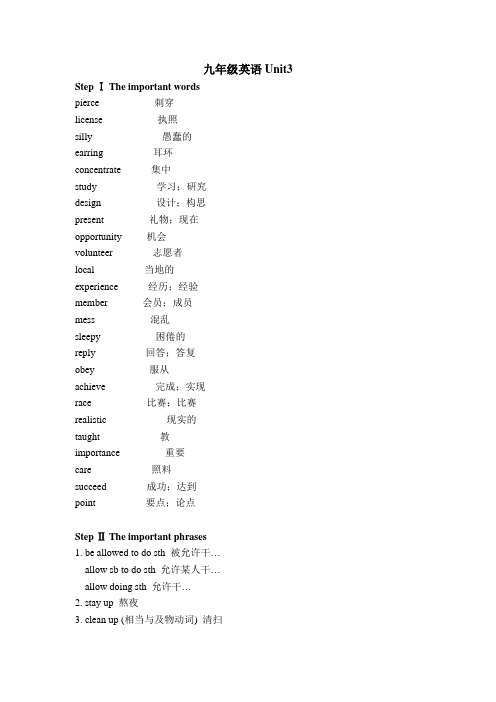
九年级英语Unit3 Step Ⅰ The important wordspierce 刺穿license 执照silly 愚蠢的earring 耳环concentrate 集中study 学习;研究design 设计;构思present 礼物;现在opportunity 机会volunteer 志愿者local 当地的experience 经历;经验member 会员;成员mess 混乱sleepy 困倦的reply 回答;答复obey 服从achieve 完成;实现race 比赛;比赛realistic 现实的taught 教importance 重要care 照料succeed 成功;达到point 要点;论点Step Ⅱ The important phrases1. be allowed to do sth 被允许干…allow sb to do sth 允许某人干…allow doing sth 允许干…2. stay up 熬夜3. clean up (相当与及物动词) 清扫4. fail (in) a test 考试不及格5. take the test 参加考试6. the other day 前几天7. concentrate on 全神贯注于8. be good for 对…有益9. learn from 向某人学习10. at present 目前,现在11. have an opportunity to do sth 有做…的机会12. at least 至少13. take time to do sth 花费时间干…14. have…off 放假,休息15. reply to 回答,答复16. get in the way of 妨碍17. think about 思考,考虑18. in the end 最后,终于19. be serious about 对…热忠/极感兴趣20. care about 关心,担心,在乎21. agree with 同意…Unit 3 Teenagers should be allowed to choose their own clothes.重点、难点、考点及疑点注释1. I don’t think twelve-year-olds should be allowed to get their ears pierced. (P18)我认为不应该允许12岁的孩子穿耳孔。
人教版新目标九年级Unit 3复习提纲

Unit 3Teenagers should be allowed to choose their own clothes一、知识点①英语有两种语态:主动语态和补动语态主动语态表示是动作的执行者被动语态表示主语是动作的承受者Cats eat fish. (主动语态)猫吃鱼。
Fish is eaten by cats.(被动语态)鱼被猫吃。
②被动语态的构成由“助动词be +及物动词的过去分词”构成助动词be 有人称、数和时态的变化,其变化规则与be 作为连系动词时完全一样。
一般现在时am、is、are +过去分词英语在很多国家被说。
一般过去时was 、were +过去分词这座桥使1980年建的。
含情态动词的情态动词+be+过去分词青少年应该被允许扎耳眼。
③被动语态的用法当我们不知道谁是动作的执行者,或者没有必要指出谁是动作的执行者,或者只需强调动作的承受者时,要用被动语态。
2. allow sb. s th. 允许某人做某事(主动语态)如:妈妈允许我每晚看电视。
被允许做某事(被动语态)如:莉莉被允许穿自己的衣服。
3.穿耳洞get、sth. done(过去分词) 、have sth. done 让/使(别人)做某事如:我让别人修好我的车我要理发.4. enough 足够形容词+enough 如:足够漂亮enough+名词如:足够食物enough to 足够…去做…如:我有足够的钱去北京。
她够大去读书了。
5. stop sth. 停止做某事请停止说话。
stop sth. 停止下来去做某事我们累了,让我们停下来休息一下6. 看起来好像…sb. seem to do sth. =他看起来好像很伤心。
7.倒装句:由so+助动词(be/do/will/have)/情态动词+主语意为:…也是一样Neither/Nor + be动词/助动词/情态动词+主语(前为否定) 表示与前面所述事实一致.她是一个学生,我也是。
初中英语人教新目标九年级全一册unit3知识点

九年级英语全一册Unit3知识点【重点单词】1.rush v.(使)仓促行事;n.仓促;急促;2.request v.要求;请求; n. 要求;请求;request sb to do sth.要求某人做某事【重点短语】1.询问信息 ask for information2.向左/右转 turn left/right3.买一双鞋 get a pair of shoes4.去三楼 go to the third floor5.路过书店 go past the bookstore6.在银行与超市之间between the bank and the supermarket7.路过 pass by8.抓住我的手 hold my hand9.听起来完美 sound perfect10.在去某地的路上on the way to sw11.请再说一次 pardon me12.沿着这条街向东走go east along this street13.一个吃饭的好地方a good place to eat14.在……的拐角处on the corner of...15.礼貌地请求帮助ask for help politely16.改变说话的方式change the way they talk17.在不同的情景 in different situations18.电子邮件地址 e-mail address19.导入一个问题 lead in to a request20.地下停车场 underground parking lot21.匆忙地 be in a rush22.第一次遇见某人meet sb for the first time23.更好地规划我的时间plan my time better24.路过pass by25.寄信 mail(send) a letter26.在购物中心 in the shopping center27.在某些场合 in some situations28.停车park one’s car29.为……感谢某人thank sb.for doing sth.30.期盼look forward to (doing) sth31.仓促地做某事 in a rush to do sth.【重点句型】1.问路常用的句子:① Do you know where is ...?② Can you tell me how can l get to …?③ Could you tell me how to get to …?④ Could/Will/Would you please tell me sth. 表示十分客气地询问事情Could you tell me how to get to the park?请你告诉我怎么才能去公园好吗?2.Can you tell me where there’s a good place to eat?你能告诉我哪有好吃的地方吗?Of course.What kind of food do you like?当然可以,你喜欢什么样的食物?3.Is that a good place to hang out?那是不是一个闲荡的好地方?4.kind of +adj/adv.有点;一点She is kind of shy.她有点害羞。
2020年春人教新目标英语九年级英语 Unit1-9 词形变化复习总结
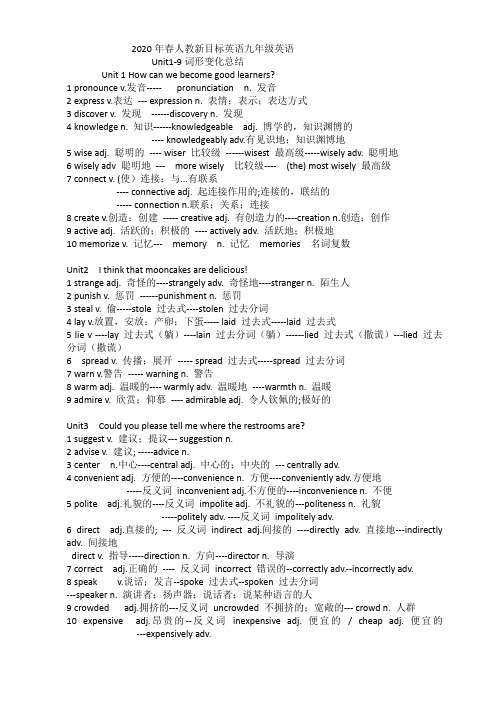
2020年春人教新目标英语九年级英语Unit1-9词形变化总结Unit 1 How can we become good learners?1 pronounce v.发音----- pronunciation n. 发音2 express v.表达--- expression n. 表情;表示;表达方式3 discover v. 发现------discovery n. 发现4 knowledge n. 知识------knowledgeable adj. 博学的,知识渊博的---- knowledgeably adv.有见识地;知识渊博地5 wise adj. 聪明的---- wiser 比较级------wisest 最高级-----wisely adv. 聪明地6 wisely adv 聪明地--- more wisely 比较级---- (the) most wisely 最高级7 connect v. (使)连接;与...有联系---- connective adj. 起连接作用的;连接的,联结的----- connection n.联系;关系;连接8 create v.创造;创建----- creative adj. 有创造力的----creation n.创造;创作9 active adj. 活跃的;积极的---- actively adv. 活跃地;积极地10 memorize v. 记忆--- memory n. 记忆memories 名词复数Unit2 I think that mooncakes are delicious!1 strange adj. 奇怪的----strangely adv. 奇怪地----stranger n. 陌生人2 punish v. 惩罚------punishment n. 惩罚3 steal v. 偷-----stole 过去式----stolen 过去分词4 lay v.放置,安放;产卵;下蛋----- laid 过去式-----laid 过去式5 lie v ----lay 过去式(躺)----lain 过去分词(躺)------lied 过去式(撒谎)---lied 过去分词(撒谎)6 spread v. 传播;展开----- spread 过去式-----spread 过去分词7 warn v.警告----- warning n. 警告8 warm adj. 温暖的---- warmly adv. 温暖地----warmth n. 温暖9 admire v. 欣赏;仰慕---- admirable adj. 令人钦佩的;极好的Unit3 Could you please tell me where the restrooms are?1 suggest v. 建议;提议--- suggestion n.2 advise v. 建议; -----advice n.3 center n.中心----central adj. 中心的;中央的--- centrally adv.4 convenient adj. 方便的----convenience n. 方便----conveniently adv.方便地-----反义词inconvenient adj.不方便的----inconvenience n. 不便5 polite adj.礼貌的----反义词impolite adj. 不礼貌的---politeness n. 礼貌-----politely adv. ----反义词impolitely adv.6 direct adj.直接的; --- 反义词indirect adj.间接的----directly adv. 直接地---indirectly adv. 间接地direct v. 指导-----direction n. 方向----director n. 导演7 correct adj.正确的---- 反义词incorrect 错误的--correctly adv.--incorrectly adv.8 speak v.说话;发言--spoke 过去式--spoken 过去分词---speaker n. 演讲者;扬声器;说话者;说某种语言的人9 crowded adj.拥挤的---反义词uncrowded 不拥挤的;宽敞的--- crowd n. 人群10 expensive adj.昂贵的--反义词inexpensive adj. 便宜的/ cheap adj. 便宜的---expensively adv.Unit4 I used to be afraid of the dark.1 humorous adj. 幽默的adv. humorously n. humor2 silent adj. 不说话的,沉默的adv. silently n. silence3 help adj 有帮助的helpful adv. 有帮助地helpfully adj. 无助的helpless adv. 无助地helplessly4 deal v.对付;处理过去式dealt 过去分词dealt n.商人dealer5 require v. 需要n. requirement6 introduce v.介绍n. introduction7 absent adj. 缺席;不在adv. absently n. absence8 general adj. 总的;普遍的;常规的adv. generally 一般地;通常地v. generalize 概括, 归纳9 exact adj.确切的adv. exactly10 public adj. 公开地反义词private adj. 私人的;私密的adv. publiclyUnit5 What are the shirts made of?1 produce v. 生产;制造;出产---- n. 生产production ---- n.产品product---- n.制做人producer2 leaf n. 叶;叶子---- 名词复数leaves3 widely adv 广泛地;普遍地---- adj.广泛的,普遍的wide ---- n. 宽度width4 lively adj. 生气勃勃的;(色彩)鲜艳的---- n. liveliness 活力----比较级livelier----最高级liveliest5 local adj 当地的;本地的---- adv. locally 本地地;当地地---- v. localize 使地方化6 celebration n.庆典;庆祝活动---- v. celebrate 庆祝---- adj celebrated 著名的;有名望的7 international adj. 国际的---- adv. internationally 国际地----v . internationalize 使国际化8 history n---- adj. historical 有关历史的---- adv. historically 历史上地----n. historian 历史学家9 avoid v. 避免;回避---- adj. avoidable 可避免的----反义词adj. unavoidable 不可避免的10 competitor n. 参赛者;竞争者---- pete 竞争----n. competition 竞赛adj. competitive 竞争的;好胜的;有竞争力的Unit6 When was it invented?1 please v 使高兴;使满意----- pleased adj. 满意的----- pleasant adj.令人愉快的---- pleasure n.愉快,快乐。
人教新目标版九年级英语上册Unit 3 知识点总结

Unit 3 Could you please tell me where the restrooms are?知识点总结一、重点词汇·原文再现Oh, could you tell me where the restrooms are first?噢,你可以告诉我洗手间在哪里吗?·基本用法n. restroom 洗手间;公共厕所The restroom is at the end of the hallway to the right.洗手间在走廊尽头右转的地方。
·原文再现buy some stamps买一些邮票·基本用法n. stamp 邮票;印章,其复数形式为stamps。
I stuck the stamp on and ran to the postbox.我贴上邮票,然后向邮箱跑去。
·原文再现Excuse me, do you know where I can get some postcards?请问,你知道我从哪里可以得到一些明信片吗?·基本用法n. postcard 明信片It was very considerate of you to send me a postcard.你想得真周到,寄给我明信片。
·原文再现Pardon?请再说一遍。
·基本用法interj. 请再说一遍;抱歉,对不起。
---Will you let me open it?我能打开它吗?---Pardon?请再说一遍?----Can I open it?我能打开它吗?·原文再现I mean … you know, a washroom or bathroom.我的意思是……你知道,洗手间。
·基本用法n. bathroom 浴室;洗手间She has gone in to use the bathroom.她去洗手间了。
2020年人教版新目标英语九年级上册单元词句总结(全册)
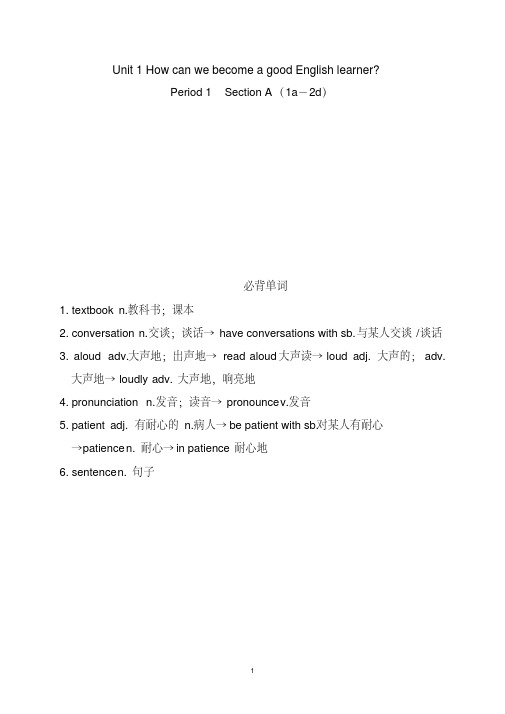
Unit 1 How can we become a good English learner?Period 1 Section A(1a-2d)必背单词1. textbook n.教科书;课本2. conversation n.交谈;谈话→have conversations with sb. 与某人交谈/谈话3. aloud adv.大声地;出声地→read aloud大声读→loud adj.大声的;adv.大声地→loudly adv. 大声地,响亮地4. pronunciation n.发音;读音→pronounce v.发音5. patient adj. 有耐心的n.病人→be patient with sb.对某人有耐心→patience n. 耐心→in patience 耐心地6. sentence n. 句子必背短语7. ask...for...请求……给予……8. study for a test 备考9. give a report作报告10. word by word 逐字11. more than多于……必背句子12. It’s too hard to understand spoken English.听懂英语口语很难。
13. It takes time.这需要时间。
14. The more you read,the faster you'll be.你读得越多,你将会越快。
Period 2 Section A(3a-3b)必背单词1. expression n.表情;表示;表达方式→express v.表达;表露2. discover v. 发现;发觉→discovery n.发现3. secret n.秘密;秘诀→keep a secret保守秘密→the secret to/of success成功的秘密→secret a dj.秘密的;保密的→secret news 秘闻4. grammar n.语法必背短语5. be afraid to do sth.不敢做某事→be afraid of doing sth.害怕做某事6. fall in love with 爱上……7. look up (在词典或参考书中)查阅;抬头看→look it /them up在词典中查阅它/它们→look up to sb.仰慕某人=admire sb.8. because of因为必背句子9. The teacher spoke so quickly that I did not understand her most of the tim 老师说得太快,以至于很多时候我都听不懂她说的话。
2020年人教新目标英语英语九年级unit3 单元知识点复习总结归纳
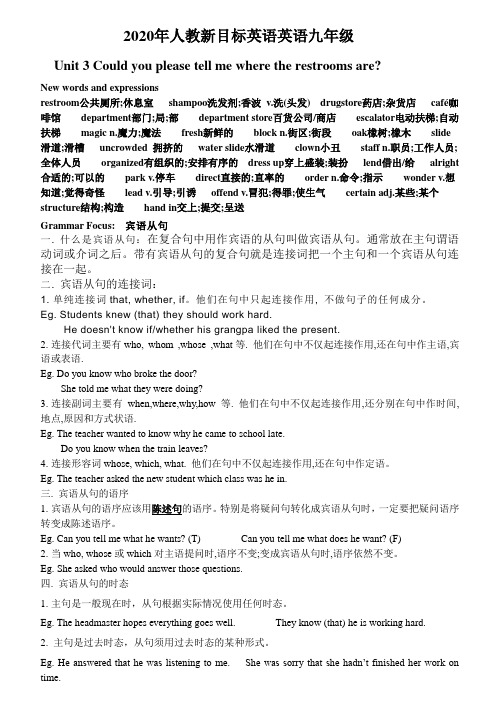
2020年人教新目标英语英语九年级Unit 3 Could you please tell me where the restrooms are?New words and expressionsrestroom公共厕所;休息室shampoo洗发剂;香波v.洗(头发) drugstore药店;杂货店café咖啡馆department部门;局;部department store百货公司/商店escalator电动扶梯;自动扶梯magic n.魔力;魔法fresh新鲜的block n.街区;街段oak橡树;橡木slide 滑道;滑槽uncrowded 拥挤的water slide水滑道clown小丑staff n.职员;工作人员;全体人员organized有组织的;安排有序的dress up穿上盛装;装扮lend借出/给alright 合适的;可以的park v.停车direct直接的;直率的order n.命令;指示wonder v.想知道;觉得奇怪lead v.引导;引诱offend v.冒犯;得罪;使生气certain adj.某些;某个structure结构;构造hand in交上;提交;呈送Grammar Focus:宾语从句一.什么是宾语从句:在复合句中用作宾语的从句叫做宾语从句。
通常放在主句谓语动词或介词之后。
带有宾语从句的复合句就是连接词把一个主句和一个宾语从句连接在一起。
二.宾语从句的连接词:1. 单纯连接词that, whether, if。
他们在句中只起连接作用, 不做句子的任何成分。
Eg. Students knew (that) they should work hard.He doesn't know if/whether his grangpa liked the present.2.连接代词主要有who, whom ,whose ,what等. 他们在句中不仅起连接作用,还在句中作主语,宾语或表语.Eg. Do you know who broke the door?She told me what they were doing?3.连接副词主要有when,where,why,how等. 他们在句中不仅起连接作用,还分别在句中作时间, 地点,原因和方式状语.Eg. The teacher wanted to know why he came to school late.Do you know when the train leaves?4.连接形容词whose, which, what. 他们在句中不仅起连接作用,还在句中作定语。
新人教版九年级unit3知识点详解
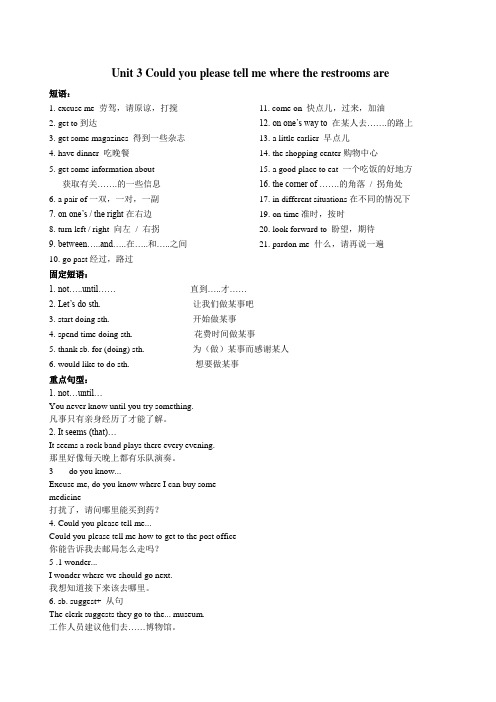
Unit 3 Could you please tell me where the restrooms are 短语:1. excuse me 劳驾,请原谅,打搅2. get to到达3. get some magazines 得到一些杂志4. have dinner 吃晚餐5. get some information about获取有关…….的一些信息6. a pair of一双,一对,一副7. on one’s / the right在右边8. turn left / right 向左/ 右拐9. between…..and…..在…..和…..之间10. go past经过,路过11. come on 快点儿,过来,加油12. on one’s way to 在某人去…….的路上13. a little earlier 早点儿14. the shopping center购物中心15. a good place to eat 一个吃饭的好地方16. the corner of …….的角落/ 拐角处17. in different situations在不同的情况下19. on time准时,按时20. look forward to 盼望,期待21. pardon me 什么,请再说一遍固定短语:1. not…..until…… 直到…..才……2. Let’s do sth. 让我们做某事吧3. start doing sth. 开始做某事4. spend time doing sth. 花费时间做某事5. thank sb. for (doing) sth. 为(做)某事而感谢某人6. would like to do sth. 想要做某事重点句型:1. not…until…You never know until you try something.凡事只有亲身经历了才能了解。
2. It seems (that)…It seems a rock band plays there every evening.那里好像每天晚上都有乐队演奏。
人教版新目标九年级英语上册Unit-3-知识点归纳

人教版新目标九年级英语上册Unit 3 知识点归纳1.取钱get some money2。
买一些杂志/邮票get/buy some magazines3.获取一些有关小镇的信息get some information about the town4.买一双鞋get/buy a pair of shoes5.买一份报纸buy a newspaper6.买一本字典buy a dictionary7。
买一些有票buy some stamps8。
吃饭have dinner9。
怎样到达…how to get to sp10。
沿着go along/ go down11.在银行的旁边beside the bank12。
在右边on the right/left13.在某人的右边on one’s right14。
去三楼go to the third floor15.向左转turn left/ right16.在…之间between …and…17.走过书店go past the bookstore18。
做…激动be excited to do sth.19.从/以…开始start/ begin with20.不必匆忙not need to rush21。
有……独特之处be special about.. 。
22。
加油,过来come on23.休息室 a room for resting24。
请再说一次pardon me25.抓住某人的手hold one’s hand26.摇滚乐队 a rock band27。
起初at first28。
在去...。
.。
的路上on one’s way to。
29。
经过、路过pass by30.开始玩start playing31.沿... 走;走上;走近walk up32.在门边at the door33.在门旁by the door:34.在那个时刻at that time35。
来得更早点come a little earlier36。
Unit3知识点总结人教版九年级英语全册

Unit 3 Could you please tell me where the restrooms are?单元重点知识总结重点词汇:1.beside prep. 在......旁边,在......附近●Please e here and sit beside me. 请过来坐在我身边。
2.pardon(1)v. 原谅●Pardon me for breaking the plate. 原谅我打碎了盘子。
(2)interj. 请再说一遍●Please write down your address. 请写下你的地址。
Pardon? 什么?3.normally adv.通常,正常情况下●Normally, it will take you 30 minutes too get there.通常,到达那里需要30分钟。
【拓展】normally的形容词形式是normal,意为“正常的,一般的”●I don’t think he is normal. 我认为他不正常。
4.rush(1)n. 仓促,急促●There is no rush. 不用着急。
(2)v. 仓促,急促●We had to rush our meal. 我们只能匆匆忙忙地吃饭。
5.suggest v. 建议,提议(1)suggest sth. 建议某事●She suggests a trip during the summer vacation.她建议在暑假期间去旅游。
(2)suggest doing sth. 建议做某事●He suggested buying a mobile phone for David.他建议给大卫买一个。
(3)suggest (that) sb. (should) do sth. 建议某人做某事●I suggest (that) you (should) have a conversation with him .我建议你和他谈谈。
人教版英语九年级Unit 3 重点知识归纳及讲解

九年级上Unit 3知识清单Section A一、重点短语1. get some magazines/stamps买些杂志/邮票2. a pair of shoes 一双鞋3. ask for the information about the town 询问关于这个小镇的消息4. pass (by) a bookstore = go past/by a bookstore 走过一家书店5.beside the back = next to/ at the side of the bank 在银行旁边6. go to the second floor 去二楼7. get some postcards 买一些卡片8. try the rides 尝试些乘骑项目9. go on sth继续某事10.be excited to do sth兴奋地做某事be excited about sth/doing sth.11. start with = begin with 以...开始end with 以…结束12. hold my hand 抓住我的手13. come on 加油;得了吧14. walk up to 走向15. go east along 沿着…(向东)走16. on one’s way to sp在去某地的路上17. get angry 饿了18. at the door 在门口19. mail a letter 寄封信20. the Italian restaurant nearby 附近的意大利餐馆二、重点句型1. I was scared first, but shouting did help. 该句话中, “did”的用法是助动词表强调,起加强语气的作用。
同类例句如:I’m not joking, we did go camping last weekend. The summer holiday does start next Monday.2. 英语常见问路/指路表达方式:1) 问路Excuse me/Pardon me, where is the nearest post office?Excuse me, which is the way to the nearest post office?Excuse me/Pardon me, can/could you (please) tell me the way to the post office?Excuse me/Pardon me, how can I get to the nearest post office?Could you please possibly tell me how to get to the library?Excuse me/Pardon me, do you know if there’s a post office around here?Would you please tell me if there is a bank nearby?I wonder +…可加以上所有句型。
人教新目标版英语九年级全册Unit3知识点汇总
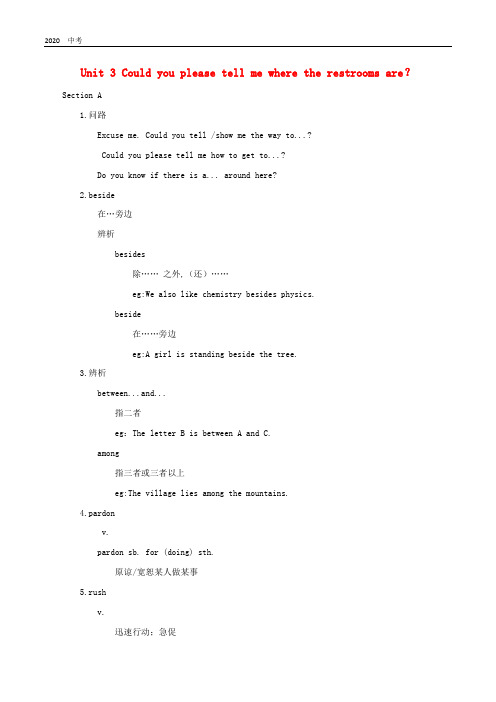
Unit 3 Could you please tell me where the restrooms are?Section A1.问路Excuse me. Could you tell /show me the way to...?Could you please tell me how to get to...?Do you know if there is a... around here?2.beside在…旁边辨析besides除…… 之外,(还)……eg:We also like chemistry besides physics.beside在……旁边eg:A girl is standing beside the tree.3.辨析between...and...指二者eg:The letter B is between A and C.among指三者或三者以上eg:The village lies among the mountains.4.pardonv.pardon sb. for (doing) sth.原谅/宽恕某人做某事5.rushv.迅速行动;急促eg: He rushed into the room and took some money.n.匆忙;繁忙in a rusheg: No matter what she does, she is always in a rush.rush hour( 上下班时的) 交通高峰期eg:If you go now, you're likely to hit the rush hour.6.suggest建议;提议eg:The old man suggests giving back the food to these villagers.advise sb. to do sth.建议某人做某事7.pass by路过;经过不注意;忽视句型pass sb. by(机会) ( 从某人旁边) 过去pass sb. sth.把某物传递给某人=pass sth. to sb.pass away去世8.宾语从句(二)if/whether是否不能省略eg:I wonder if you are a teacher.what,which,whose,whom在从句中作一定的成分,如主语、宾语、定语等When,where,why,how作状语客观事实、普遍真理、自然现象或习惯性动作等,从句用一般现在时Section B1.convenientadj.便利的;方便的It's convenient for sb. to do sth.n.不可数方便,便利可数利的事物(或设施)2.corner拐角;角落短语in the corner在拐角的里面on the corner在拐角之上at the corner在拐角边3.politelymore polite更有礼貌的less polite不如……有礼貌的4.whom谁;什么人介词之后只能用whomeg: With whom did you go shopping last weekend, Lucy ?municate和某人交流communicate with sb.和某人交流6.happen发生;出现句型sth.+ happens/happened + 地点/ 时间某地/ 某时发生了某事sth.+ happens/happened+to sb.某人出了某事( 常指不好的事)sb.+ happens/happened+to do sth.某人碰巧做某事It happens/happened that...碰巧或恰好发生……7. look forward to期待;期望后+n./pron./v.ingSection A1.问路Excuse me. Could you tell /show me the way to...?Could you please tell me how to get to...?Do you know if there is a... around here?2.beside在…旁边辨析besides除…… 之外,(还)……eg:We also like chemistry besides physics.beside在……旁边eg:A girl is standing beside the tree.3.辨析between...and...指二者eg:The letter B is between A and C.among指三者或三者以上eg:The village lies among the mountains.4.pardonv.pardon sb. for (doing) sth.原谅/宽恕某人做某事5.rushv.迅速行动;急促eg: He rushed into the room and took some money.n.匆忙;繁忙in a rusheg: No matter what she does, she is always in a rush.rush hour( 上下班时的) 交通高峰期eg:If you go now, you're likely to hit the rush hour.6.suggest建议;提议eg:The old man suggests giving back the food to these villagers.advise sb. to do sth.建议某人做某事7.pass by路过;经过不注意;忽视句型pass sb. by(机会) ( 从某人旁边) 过去pass sb. sth.把某物传递给某人=pass sth. to sb.pass away去世8.宾语从句(二)if/whether是否不能省略eg:I wonder if you are a teacher.what,which,whose,whom在从句中作一定的成分,如主语、宾语、定语等When,where,why,how作状语客观事实、普遍真理、自然现象或习惯性动作等,从句用一般现在时Section B1.convenientadj.便利的;方便的It's convenient for sb. to do sth.n.不可数方便,便利可数利的事物(或设施)2.corner拐角;角落短语in the corner在拐角的里面on the corner在拐角之上at the corner在拐角边3.politelymore polite更有礼貌的less polite不如……有礼貌的4.whom谁;什么人介词之后只能用whomeg: With whom did you go shopping last weekend, Lucy ?municate和某人交流communicate with sb.和某人交流6.happen发生;出现句型sth.+ happens/happened + 地点/ 时间某地/ 某时发生了某事sth.+ happens/happened+to sb.某人出了某事( 常指不好的事)sb.+ happens/happened+to do sth.某人碰巧做某事It happens/happened that...碰巧或恰好发生……7. look forward to期待;期望后+n./pron./v.ing。
- 1、下载文档前请自行甄别文档内容的完整性,平台不提供额外的编辑、内容补充、找答案等附加服务。
- 2、"仅部分预览"的文档,不可在线预览部分如存在完整性等问题,可反馈申请退款(可完整预览的文档不适用该条件!)。
- 3、如文档侵犯您的权益,请联系客服反馈,我们会尽快为您处理(人工客服工作时间:9:00-18:30)。
2020年人教新目标英语英语九年级Unit 3 Could you please tell me where the restrooms are?New words and expressionsrestroom公共厕所;休息室shampoo洗发剂;香波v.洗(头发) drugstore药店;杂货店café咖啡馆department部门;局;部department store百货公司/商店escalator电动扶梯;自动扶梯magic n.魔力;魔法fresh新鲜的block n.街区;街段oak橡树;橡木slide 滑道;滑槽uncrowded 拥挤的water slide水滑道clown小丑staff n.职员;工作人员;全体人员organized有组织的;安排有序的dress up穿上盛装;装扮lend借出/给alright 合适的;可以的park v.停车direct直接的;直率的order n.命令;指示wonder v.想知道;觉得奇怪lead v.引导;引诱offend v.冒犯;得罪;使生气certain adj.某些;某个structure结构;构造hand in交上;提交;呈送Grammar Focus:宾语从句一. 什么是宾语从句:在复合句中用作宾语的从句叫做宾语从句。
通常放在主句谓语动词或介词之后。
带有宾语从句的复合句就是连接词把一个主句和一个宾语从句连接在一起。
二. 宾语从句的连接词:1. 单纯连接词that, whether, if。
他们在句中只起连接作用, 不做句子的任何成分。
Eg. Students knew (that) they should work hard.He doesn't know if/whether his grangpa liked the present.2.连接代词主要有who, whom ,whose ,what等. 他们在句中不仅起连接作用,还在句中作主语,宾语或表语.Eg. Do you know who broke the door?She told me what they were doing?3.连接副词主要有when,where,why,how等. 他们在句中不仅起连接作用,还分别在句中作时间, 地点,原因和方式状语.Eg. The teacher wanted to know why he came to school late.Do you know when the train leaves?4.连接形容词whose, which, what. 他们在句中不仅起连接作用,还在句中作定语。
Eg. The teacher asked the new student which class was he in.三.宾语从句的语序1.宾语从句的语序应该用陈述句的语序。
特别是将疑问句转化成宾语从句时,一定要把疑问语序转变成陈述语序。
Eg. Can you tell me what he wants? (T) Can you tell me what does he want? (F)2.当who, whose或which对主语提问时,语序不变;变成宾语从句时,语序依然不变。
Eg. She asked who would answer those questions.四.宾语从句的时态1.主句是一般现在时,从句根据实际情况使用任何时态。
Eg. The headmaster hopes everything goes well. They know (that) he is working hard.2. 主句是过去时态,从句须用过去时态的某种形式。
Eg. He answered that he was listening to me. She was sorry that she hadn’t finished her work on time.3. 当宾语从句表示的是一个客观真理或者事实时,即使主句是过去时,从句也用一般现在时态。
Eg. The teacher told his class that light travels faster than sound.Father told me that practice makes perfect.五.否定转移主句为I/We think (believe, guess, suppose...)时, 从句若表示否定, 一般将否定词not转移到主句的谓语中, 这种现象就叫作“否定转移”Eg. I don't think chickens can swim. I don't believe he will come.六.宾语从句与简单句的互相转换当宾语从句是以连接代词或连接副词如when, where, who, why, which, what, whose等引导时, 有时可以转换成由连接代词或连接副词加to do,从而由一个主从复合句变成简单句. Eg. I don't know what I shall do next. =I don't know what to do next.John didn't decide which shirt he would buy. =John didn't decide which shirt to buy.当主句中含有双宾语时, 如果间接宾语与宾语从句(直接宾语)中的主语一致时, 也可以将这个主从复合句变成简单句.Eg. Can you tell me how I can get to the police station?= Can you tell me how to get to the police station?Please show me how I should play this game. =Please show me how to play this game.1.there be句型(略)2.wear/ dress/ be in/ put on/dress up/ have on/ try on “穿;戴”1) wear: 及物动词,强调穿/戴的状态。
后面除了跟表示衣服,鞋,帽,首饰,眼镜等词外,还可以跟表示胡须,发型等的词。
Eg. Frank is wearing blue pants and a white shirt today.2) dress可作及物动词,有“穿着,打扮”的意思,但只用于穿衣,常用于下列结构:dress sb/oneself, dress well和get dressed等。
Eg. Mary was dressing her doll.3) be in 强调穿的状态,宾语既可以是表示衣物,帽子等的词,也可以是表颜色的词.Eg. You are so beautiful in the yellow skirt.4) put on“戴上,穿上”,表示动作,其反义词是take off. Eg. Put on your coat please!5) dress up意思是“盛装打扮”, 如果与as连用则翻译为“打扮成…的样子”Eg. They dressed up for the coming evening party.6) have on是“穿着”的意思,指穿的状态. have on不用于进行时态. Eg. He has a blue coat on.7) try on表示“试穿(衣,帽,鞋)”Eg. This coat is too small. May I try on another one?3. 名词所有格(略)4. “花费”句型小结:(1)某人买东西花多少钱: (2)某人做某事花费多少时间1) 人+spend+钱+on sth 1)人+spend+时间+in(可省略)+动名词形式2) 人+pay+钱+for sth 2)It takes sb some time to do sth3) 物+cost+人+钱4)人+buy+物+for+钱5. lend用法lend sb sth = lend sth to sb 其反义短语为borrow sth from sbEg. Can you lend me 30yuan till Saturday? =Can you lend 30yuan to me till Saturday?lend sb a hand帮助某人做某事(尤指需要体力的事)Eg Will you please lend me a hand with the heavy box?6. order n.命令;指示Eg. You must obey my orders.n. 顺序Eg. Put these sentences in the right order.v. 命令Eg. His mother ordered him to clean the room at once.与order相关的短语: in order按顺序;整齐in order to/that 为了;以便于out of order出故障;工作不正常under the order of sb在某人的指令下;受某人的指挥7. lead v.引导;引诱其过去式和过去分词均为led. Eg. All roads lead to Rome.mislead v.误导,是lead的反义词。
leader n.先导;领导人与lead相关的短语:lead the way领路;带路lead a …life过…的生活Eg. She can lead the way to the zoo. We lead a happy life.8. in a way从某一方面来说;就某种程度而言Eg. I won’t let you do that in a way.归纳:by the way顺便说/问一下in this way用这种方法in the way妨碍;挡路on the/one’s way to 在(某人)去…的路上lose one’s way 迷路in no way决不make one’s way排除困难前进9. alright/ That’s all right. /That’s rightalright =all right 有三种用法: 1)用在系动词后, 表示健康状况,相当于fine或well, 意为“身体好,病好了”;2)表示赞同对方的意见, 意为“行,好吧”; 3)表示“令人满意的, 顺利的”之意。
